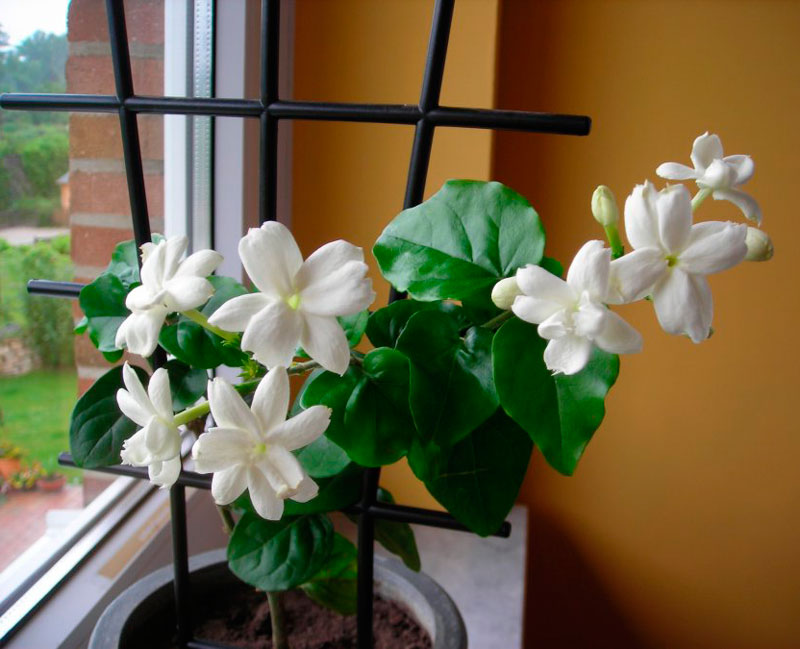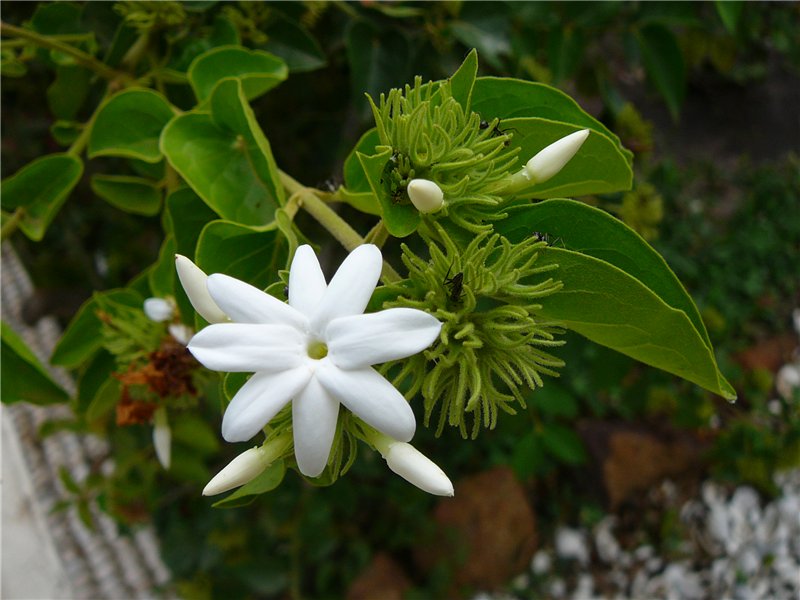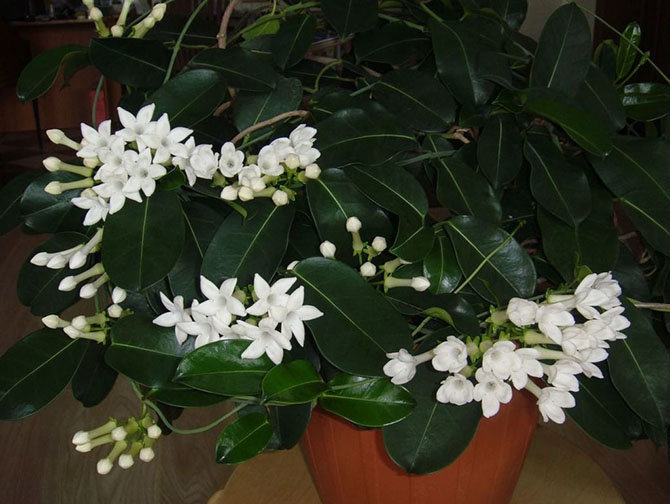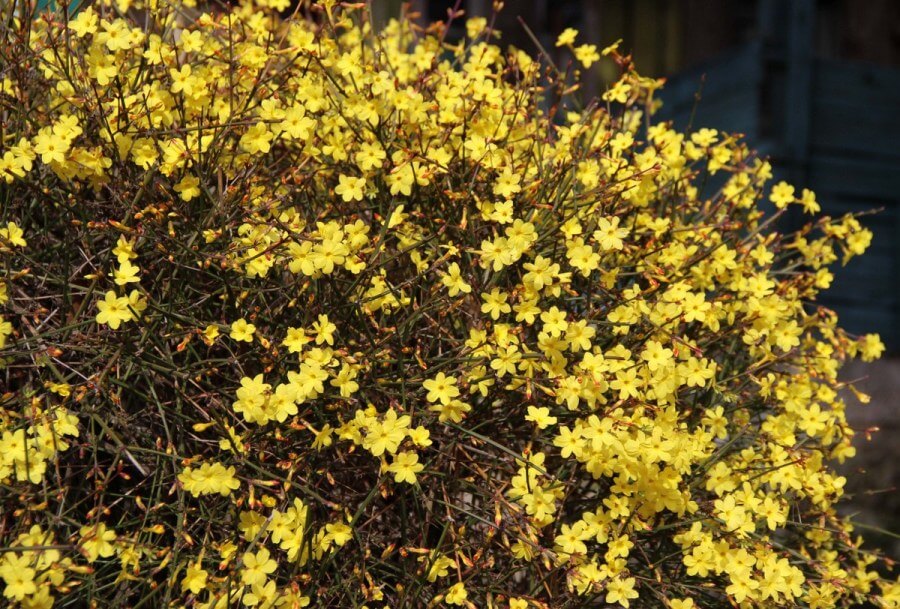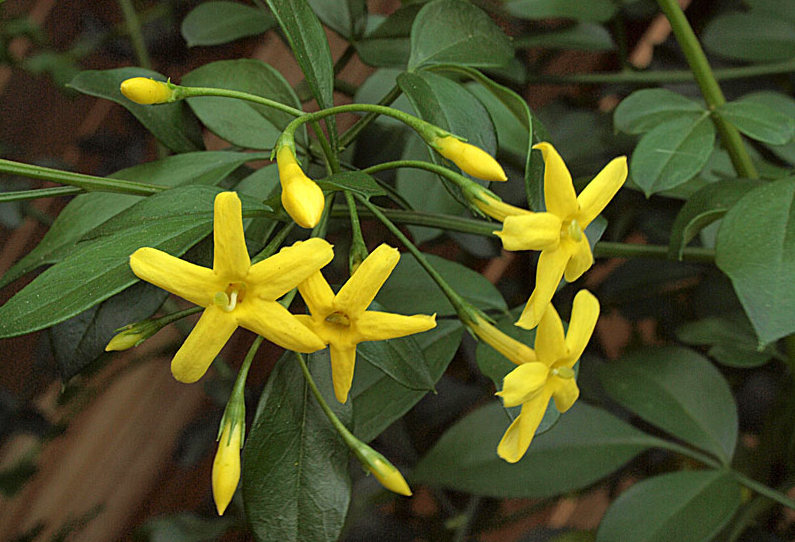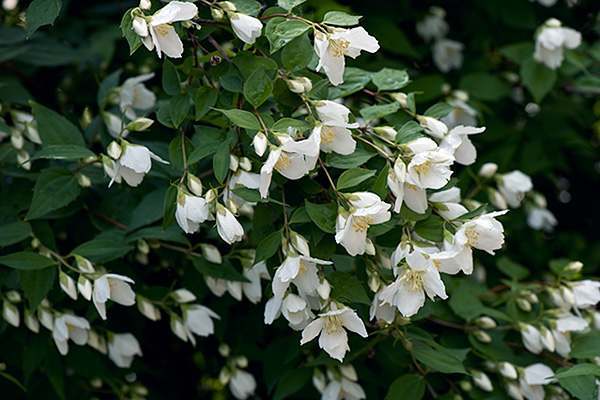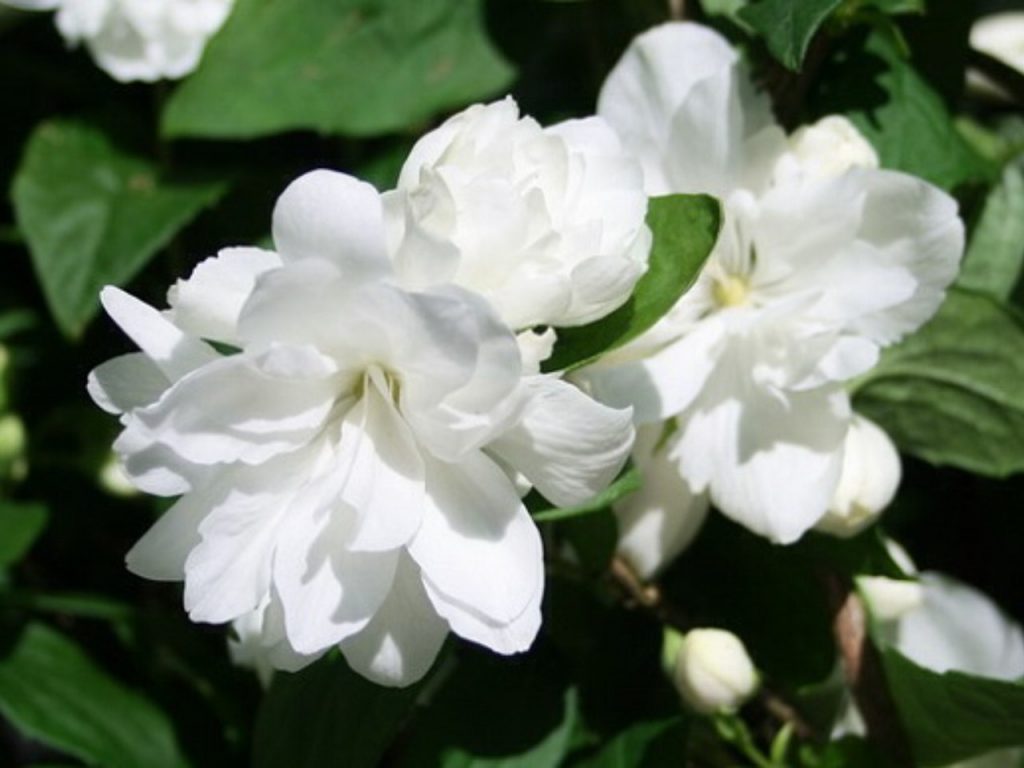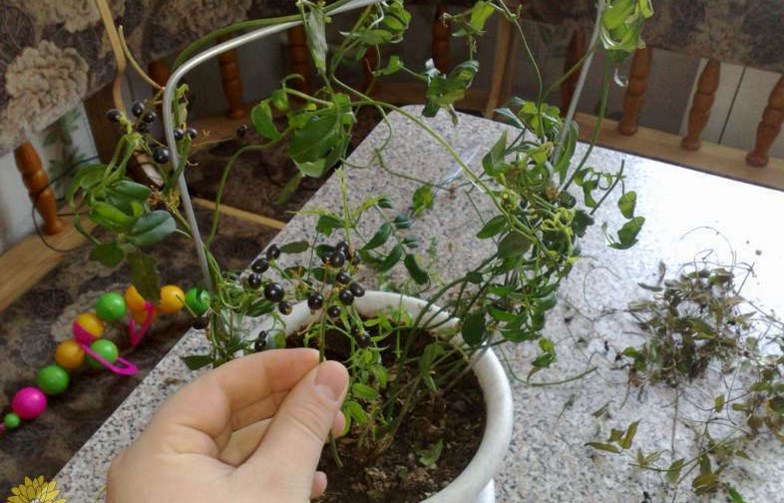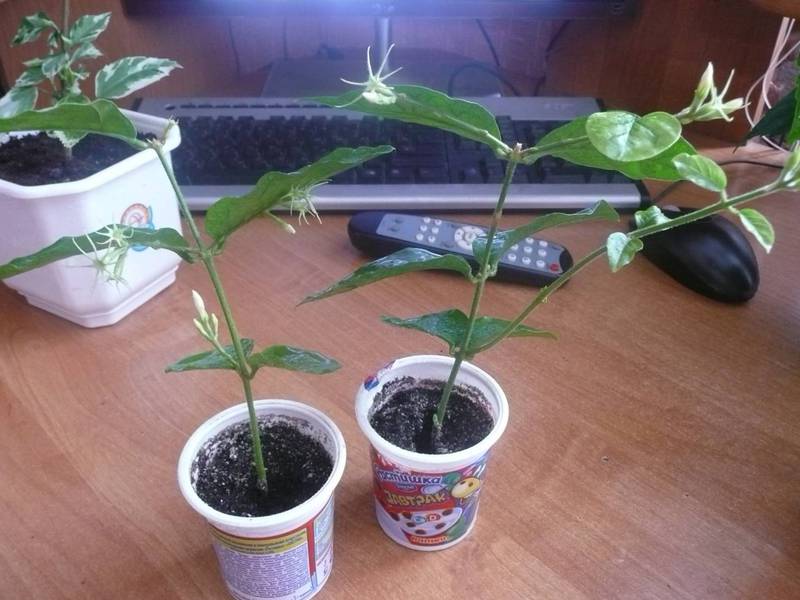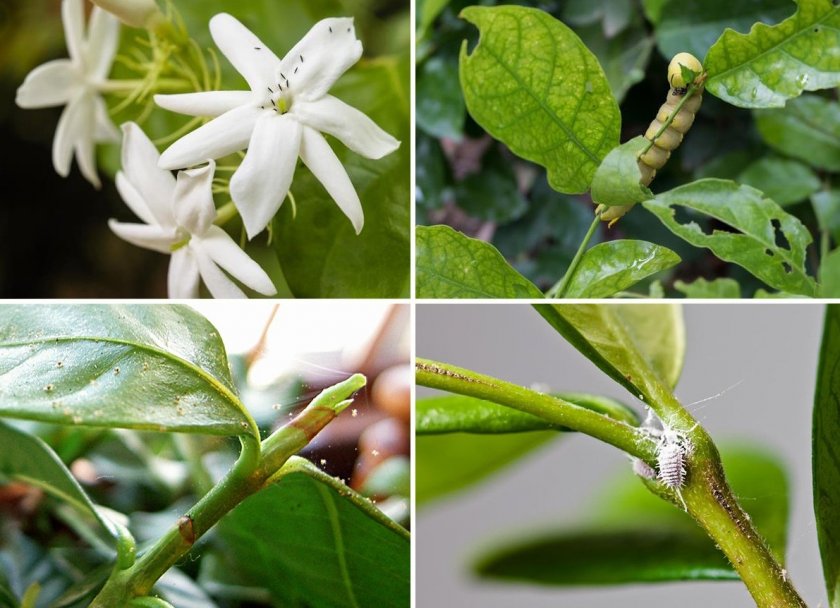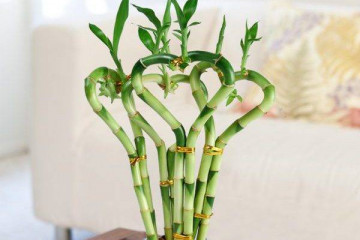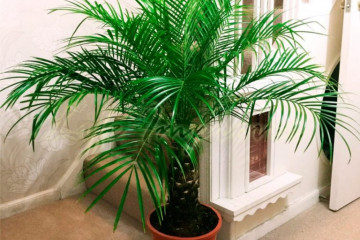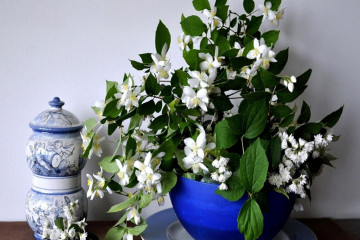Indoor jasmine - home care
Content:
The list of evergreen perennials includes indoor jasmine. Plants are known for their attractive scent during flowering; most domestic varieties do not require special knowledge and skill in their care.
Indoor jasmine
Initially, the decorative flower comes from the Australian and South American lands.
Jasmine is an indoor flower, which is characterized by whole-extreme foliage, oval-oblong shape with slightly pointed tips. Terry tubular buds are pink, cream, yellow or white.
The homemade jasmine flower has been cultivated in the gardens of the Chinese emperors since the 11th century. With the help of Spanish sailors, he got to Europe and quickly gained popularity.
Common varieties
There are many domestic varieties of culture. Florists can choose them for the color of the buds, whimsicality and ease of maintenance.
- Jasmine Sambac
It is considered an unpretentious variety, easy to grow. It grows up to 6 m in height, over time, its vines become ligneous. Foliage with an ovoid shape is collected in whorls. It can bloom with semi-double or double buds.
- Pink jasmine
It begins to bloom from the end of spring, the shoots grow up to 1.9 m. The leaves are of a dark green shade with an oval shape, pinkish flowers are on the upper sections of the stems.
A blooming culture has a delicate and pleasant aroma.
- Madagascar jasmine
It is a representative of abundant flowering crops, with dark green leathery oval foliage. Asterisk flowers increase the decorative effect of the bush, collected in lush bunches. Bud formation begins in spring and lasts up to 10 months in a row.
- Jasmine multiflorous
It has weakly branching climbing shoots, 1.8 m long. Petals with a pinkish tinge, the culture blooms from the end of winter to the last week of August.
- Jasmine
The bright yellow tubular flowers form in March, and the long shoots are adorned with green bark. The variety can grow up to 3 m in height; wild individuals are found in the Crimea.
The variety has weak shoots prone to fracture.
- Yellow jasmine
Refers to poisonous subspecies, the danger is its juice. Differs in long flowering, the lower part of the stems is covered with bark.
- Jasmine strawberry
Compact shrubs with thin stems do not exceed 1.5 m in size. The annual growth of shoots is from 4 to 7 cm, heavy buds make the branches bend over. The leaves are pointed in the upper area.
- Jasmine virginal
An upright bush grows up to 3 m in height, at the crown there is an increased density.On the shoots there are large leaf plates, they become yellow-leaved with the arrival of autumn. Terry buds reach 5 cm in diameter, like the Royal Jasmine.
Features of caring for indoor jasmine at home
Caring for indoor jasmine at home depends on the varietal accessory. If you follow the instructions exactly, you can get healthy and long-lasting flowering bushes.
Temperature
During the growing season, the temperature regime is observed from 19 to 22 degrees, in winter, the indicators can drop to 12 degrees.
Lighting
Bushes prefer diffused light. In the cold season, its deficiency is replenished with a phytolamp.
Watering
Moistening the soil is carried out after the upper layers of the soil have dried. In the spring and autumn, watering at home is carried out twice a week, in the summer - every other day.
Spraying
Daily spraying of bushes is done before budding begins.
Humidity
There must be high humidity in the room. The required mode is achieved by spraying.
Priming
The level of friability is of particular importance - air and moisture should easily penetrate to the root system.
Top dressing
Organic and mineral fertilizers are applied twice a month, from autumn the frequency is reduced.
In winter, the soil is not fertilized - the dormant period runs from November to March.
Indoor jasmine bloom
Improvement in budding is achieved by a temperature of 12-16 degrees in the cold season. During this period, watering is carried out every 10 days.
The buds resemble oblong tubes, they are double, semi-double and simple. They are collected in inflorescences located at the top or on the sides of the shoot.
All buds have a similar appearance: with a saucer-shaped rim and a cylindrical elongation.
Flowering period
When jasmine blooms: the timing depends on the variety; in most species, budding takes place from spring to autumn.
In order for the bush to bloom longer, pinching the top at the level of the seventh leaf is required. Do not allow the substrate to dry out and reduce air humidity.
Jasmine pruning
Like jasmine, they always cut it: shorten it by 30%. The procedure is carried out in March.
How jasmine reproduces
The culture can be propagated by cuttings, by seed and by means of air layers.
Germinating seeds
The seed is soaked for 48 hours, a little Kornevin is added to the liquid. The prepared seeds are sown into the soil to a depth of 1 cm. The plantings are sent to a room with a temperature of 22-25 degrees and watered regularly.
Rooting cuttings
Pieces 15 cm long are cut off from mothers. The cuttings are placed in a pot with water, before that they must be dipped in Kornevin's solution and dried for 5-10 minutes. After the appearance of the roots, they are planted in an individual container.
Air layering
Pre-prepare containers and fill them with a substrate. They are placed near an adult bush, an incision is made on its lower part and pressed against the surface of the soil of a small container. They use studs for fastening, do not forget to water regularly.
Jasmine transplant
Adult bushes are transplanted every 3 years, young ones - annually. Drainage is poured into the container, on top - a store soil mixture for roses or azaleas.
Possible problems in growing jasmine
When caring for jasmine, mistakes can be made, which will lead to the appearance of parasitic insects or diseases.With timely assistance and treatment, shrubs can be saved from death.
Drops buds and leaves
The loss of flowers and foliage is associated with both underfilling and overflowing. Some representatives react this way to drafts.
Leaves turn pale
What is the reason for the color change? Blanching of leaf plates is provoked by:
- hard and cold water;
- lack of nutrients in the substrate;
- drafts;
- excessive lighting.
The tips of the leaves dry
Drying in leaf plates is provoked by a strong drying out of the soil. The culture needs a revision of the irrigation schedule.
The lower leaves fall
The fall of low foliage is associated with natural aging and lignification of the stems. To avoid the problem, shrubs are regularly pinched and pruned in the spring season.
Pests
Common parasites include spider mites and aphids. Insects damage leaf plates and stems, causing them to turn yellow and dry. To prevent their appearance, you need to maintain an optimal moisture regime, do not forget about regular inspection of the culture.
In case of multiple attacks of parasites, you can mechanically clean the green part with soapy water and a sponge. If the expected effect is absent, then insecticidal solutions are used.
Other problems
The gradual drying of the stems can be provoked by the excess alkali content in the soil. The issue is solved by removing the top layer and adding a fertile layer. Some experts advise to carry out a complete replacement of the substrate in the container.
Prolonged lack of budding is often associated with:
- with a deep planting of the root collar;
- lack of nutrients;
- lack of light or direct sunlight on the foliage;
- insufficient or abundant watering;
- cold room.
After correcting these factors, the plant will give a large number of buds.
It is not difficult to care for and grow jasmine - with the exact implementation of the recommendations indicated by the breeders. Watering, feeding, timely transplanting will help to grow a healthy and flowering shrub.
